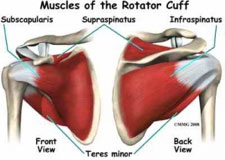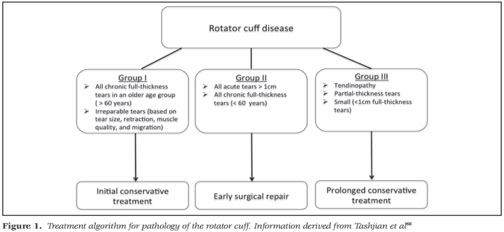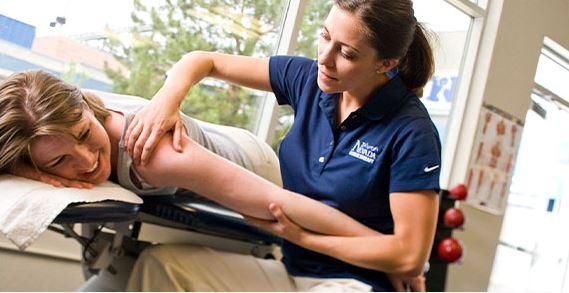Rotator Cuff Tear: Surgery? No Surgery?
Did a recent MRI confirm a Rotator Cuff Tear (RCT)? You are not alone! RCT is a common musculoskeletal injury that results from trauma or age related changes. The purpose of this blog post is to discuss non-surgical options for a rotator cuff injury and when surgery may be indicated. Petri et al. (2016) reviewed multiple clinical outcome studies and found conservative management for rotator cuff tears to have a 75% success rate1 That is a very promising statistic, as most rotator cuff injuries can be managed well with physical therapy. With this success rate, does that mean there will still be pain? Not likely! Here are a few imaging studies that confirm we can have rotator cuff pathology with no symptoms. Frost et al. (1999) showed rotator cuff pathology was related to age but did not correlate the MRI findings with symptoms.2 Girish et al. (2011) found abnormalities in 96% of asymptomatic (no symptoms) individuals.3 Do these tears get worse if I do not have surgery? In a study by Kong et al. (2017) found partial thickness tears to progress in 16% of their participants. BUT, the more important statistic from the study was, 25% of the tears decreased in size.4

Kuhn et al. (2013) analysis found most patients will elect to have surgery if conservative management fails at week 12.5 We would agree, three months is a good trial of physical therapy before deciding to go under the costly knife. An important aspect of this trial is patient optimism; Dunn et al. (2016) found, “A patient's decision to undergo surgery is influenced more by low expectations regarding the effectiveness of physical therapy than by patient symptoms or anatomic features of the rotator cuff tear.”6 A study reviewed by Edwards et al. (2016) found four factors to contribute to better non-operative outcomes; preserved range of motion in external rotation (>52 degrees), negative impingement signs, little or no atrophy of the supraspinatus muscle [1 of 4 rotator cuff muscles], and a preserved intramuscular tendon of the supraspinatus.7 If the patients presented with at least three of the above criteria, there was a 87% success rate in non-operative management.7
In the picture below, Edwards et al. (2016) presents an algorithm on nonoperative vs. operative management of a rotator cuff tear.7

Why does physical therapy help? Correctly dosed rehabilitation can help reduce pain, improve non-optimal movement strategies, and strengthen the intact rotator cuff tendon complex to improve your quality of life. Find out here what we think makes a good physical therapist. Diving into a little bit of the tendon science aspect, tendons respond positively to mechanical loading which is strength training. Tendons break down from cyclic loading which is repetitive motion activity. If you would like to learn more about tendons and how physical therapy can help reference here. Another aspect of physical therapy care is workload management, which is a key component to helping you return to the activities you love. Here, you will find our newsletter on workload management and how this can help reduce your risk of injury.
In conclusion, correctly dosed rehabilitation including but not limited to, building tendon strength, optimizing your shoulder movement and positional tolerance, as well as workload management is essential to help you return to your prior level of activity and function. If you would like to find out more how we can help you, we offer free phone consultations as well as in-person discovery visits where you can come in and see what we’re all about!
Written by: Dakota Ezell, PT, DPT
References:
-
Petri M, Ettinger M, Brand S, Stuebig T, Krettek C, Omar M. Non-Operative Management of Rotator Cuff Tears. Open Orthop J. 2016;10:349-356.
-
Frost P, Andersen J, Lundorf E. Is supraspinatus pathology as defined by magnetic resonance imaging associated with clinical sign of shoulder impingement?. J Shoulder Elbow Surg. 1999;8(6):565-568. doi:10.1016/s1058-2746(99)90090-3
-
Girish G, Lobo L, Jacobson J, Morag Y, Miller B, Jamadar D. Ultrasound of the Shoulder: Asymptomatic Findings in Men. American Journal of Roentgenology. 2011;197(4):W713-W719. doi:10.2214/ajr.11.6971
-
Kong B, Cho M, Lee H, Choi Y, Kim S. Structural Evolution of Nonoperatively Treated High-Grade Partial-Thickness Tears of the Supraspinatus Tendon. Am J Sports Med. 2017;46(1):79-86. doi:10.1177/0363546517729164
-
Kuhn JE, Dunn WR, Sanders R, et al. Effectiveness of physical therapy in treating atraumatic fullthickness rotator cuff tears: a multicenter prospective cohort study. J Shoulder Elbow Surg. 2013;22(10):1371–1379.
-
Dunn WR, Kuhn JE, Sanders R, et al. 2013 Neer Award: predictors of failure of nonoperative treatment of chronic, symptomatic, full-thickness rotator cuff tears. J Shoulder Elbow Surg. 2016;25(8):1303-11.
-
Edwards P, Ebert J, Joss B, Bhabra G, Ackland T, Wang A. Exercise Rehabilitation in the Non-Operative Management of Rotator Cuff Tears: A Review of the Literature. Int J Sports Phys Ther. 2016;11(2):279-301.




